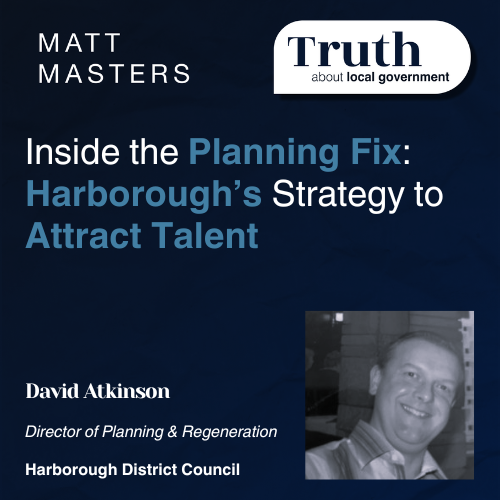Inside the Planning Fix: Harborough’s Bold Strategy to Attract and Retain Talent
- truthaboutlocalgov
- Jul 15
- 9 min read
Updated: Jul 17
In the face of a growing national recruitment crisis within local government planning departments, Harborough District Council has emerged as a standout example of innovation, resilience, and cultural transformation. Across the UK, councils are struggling to fill permanent planning roles, often relying heavily on interim or agency staff to plug the gaps—an approach that not only strains budgets but also undermines long-term service continuity and staff morale.
Against this backdrop, Harborough’s story offers a refreshing and instructive counter-narrative. In a recent episode of the “Inside the Planning Fix” podcast, host Matthew Masters sat down with David Atkinson, the council’s Director of Planning and Regeneration, to explore how Harborough turned its planning department around. What emerged was a compelling account of leadership, vision, and the power of empathy in public service.
This blog unpacks the key insights from that conversation, offering a roadmap for other councils navigating similar challenges. From structural reform to cultural renewal, Harborough’s journey is a case study in how to build a planning service that not only functions efficiently but also inspires those who work within it.
The Challenge: A Culture Under Strain
“Recruiting planners has never been more challenging,” Masters began, setting the tone for a discussion that would resonate with local authority leaders across the country. He pointed to the widespread reliance on contingent labour—interim staff and agency workers—as a symptom of deeper systemic issues. This over-reliance, he noted, is “driving real issues into the budgetary pressures that local authorities are facing.” Harborough was no exception. Atkinson painted a candid picture of a department under pressure.
“The directorate had been subject to a brutal efficiency drive,” he explained. “Cost savings were high up the list of priorities. We’d had to make a number of redundancies, and the directorate had been through previous job evaluation exercises that had a sub-optimal effect.”

While the team continued to meet its statutory obligations, the internal culture was deteriorating. “We were efficient. We were effective. We were still delivering the needs of the council and the district,” Atkinson said. “But we weren’t dealing with them in a particularly positive way… It was more of an attritional approach.”
The toll on staff morale was becoming increasingly evident.
“I was getting increasingly worried about the prolonged impacts that were being felt by colleagues across the directorate,”
he admitted. It was clear that something had to change—not just in terms of structure, but in mindset and culture.

The Turning Point: A Vision for Change
Recognising that the status quo was unsustainable, Atkinson made the bold decision to initiate a comprehensive transformation. “I felt a new approach and culture were needed,” he said. The cornerstone of this transformation was a full-scale, root-and-branch job evaluation process—one that would not only reassess roles but also reframe how the department valued its people.
“We completely reviewed all the posts in the directorate, particularly in the regulatory part where these issues tended to manifest,” he explained. “We took a fresh, expansive and positive approach to job evaluation.”
This wasn’t a tick-box exercise. Atkinson and his team actively engaged with the independent job evaluation panel, advocating for the value and complexity of each role. “We basically sold it, Matt. We sold the roles to the independent panel,” he said with conviction.
The outcome was transformative. “We got a really positive result,” Atkinson reported. “We regraded a good number of the posts in the directorate, got rid of ten years of decline if I can put it that way, and we transformed morale and atmosphere.”
But the reform didn’t stop there. Harborough also began investing in the future of the profession by building stronger ties with universities, colleges, and schools.
“We’re looking to attract people into the profession at different early stages of their training lives,” Atkinson said. “After GCSEs, after A-levels, and after degrees—we’re trying to expand our societal reach.”
Leadership in Action: Selling the Vision
Atkinson’s success wasn’t just about process—it was about leadership. He understood that to bring about meaningful change, he needed to secure buy-in from the top. “I worked with the Chief Executive,” he said. “I talked to them about the issues the directorate was facing… and I went to them with a vision.”
That vision was rooted in community and placemaking. “Community, community, community; placemaking, placemaking, placemaking,” he repeated, underscoring the values that would guide the transformation. “I wanted to make it more empathetic… to make people feel they owned the service they were offering the district.”
This wasn’t just about internal reform—it was about redefining the council’s relationship with its residents. “We needed to flip the culture from being very mechanical to being much richer and human,” he added. “That has developed into not just the service delivery in the district, but the way we mutually support our colleagues within as well.”
By framing the transformation in terms of both internal well-being and external impact, Atkinson was able to rally support from the Corporate Management Team and elected members alike. His approach serves as a powerful reminder that cultural change starts with a compelling narrative—and the courage to tell it.

Embedding a Positive Culture: Day-to-Day Realities
Transforming a department’s culture is one thing—embedding that culture into the everyday experience of staff is another. For David Atkinson, the key to sustaining Harborough’s new ethos lies in consistent, visible leadership and genuine human connection.
“It’s about communication,” he explained. “It’s about being visible. It’s about me understanding and getting to know my colleagues as people at whatever level they are.”
This isn’t just a leadership mantra—it’s a daily practice. Atkinson makes it a personal priority to meet every new starter, ensuring that from day one, they feel welcomed, seen, and supported. “I’m always on the floor,” he said. “Walking around the desks, chatting to people in planning admin one minute, team leaders the next.”
This hands-on approach has helped foster what he describes as a “mini society” within the workplace—an environment where mutual support, camaraderie, and empathy are not just encouraged but expected. “We spend a good part of our lives at work,” he noted. “So we need to operate as a mutually supportive society within that.” Atkinson’s goal is simple but profound: “If I was asked one question—what do you want to make people feel at work?—it’s to make them feel comfortable and confident.” When staff feel safe and empowered, he believes, they are more likely to thrive, contribute meaningfully, and take pride in their work.

Overcoming Resistance: Winning Over the Sceptics
No cultural transformation is without its hurdles. Atkinson was candid about the resistance he encountered, particularly from long-serving staff who had weathered previous, less successful reform efforts.
“Staying the course… exhibiting the necessary determination and tenacity… maintaining my strong ethos of authenticity—that was the biggest challenge,” he reflected.
Some colleagues were understandably sceptical. “You’ve done all this before,” they would say. “We’ve seen all this before.” These were the voices of experience, but also of disillusionment—people who had hoped for change in the past and been let down.
Rather than dismissing these concerns, Atkinson focused on building momentum among those who embraced the new direction. “It was about developing those people who are can-do and positive, and making sure their messages were louder than the naysayers.”
Over time, even the sceptics began to shift. “I was pleasantly surprised,” he said. “The people who’ve been here for years gradually came on board… They are now the biggest protagonists of what we’re trying to do.” Their transformation, he believes, is a testament to the authenticity and staying power of the new culture. “They’ve been waiting for it,” he said. “And now that it’s here to stay, they’re almost relieved they stayed around to see it happen.”
Advice to Other Councils: Don’t Settle

For other local authorities facing similar challenges, Atkinson’s advice is both practical and inspiring.
“Don’t just accept what is there,” he urged. “Pause, reflect, and look to reset. It doesn’t have to be the same moving forward as it’s been in the past.”
He encouraged leaders to trust their instincts and speak up when something isn’t working. “Be truthful to yourself and your leadership style. Say, ‘This culture is not working.’ Have the courage of your convictions.” Atkinson also highlighted the value of external support. “You could engage the Planning Advisory Service to do a peer review,” he suggested. “They can send independent people in and make some really powerful and positive recommendations.” Ultimately, he believes that meaningful change begins with a clear, compelling vision—and the willingness to challenge the status quo. “Don’t try carrying on making, doing and mending,” he warned. “If you do, you’ll always go backwards.”
Tailoring the Message: Officers vs. Members
One of the most insightful aspects of Atkinson’s approach is his nuanced understanding of communication. He recognises that different stakeholders require different messages—and that effective leadership means knowing how to speak to each audience.
“With officers and senior leadership, it’s about how the council operates—effective governance and implementation,” he explained. “With Members, it’s about how we can appear positive and have that positive relationship with their communities.”
He understands that elected officials are ultimately accountable to their constituents. “They’re in the business of getting elected and staying elected,” he said. “Selling it to them is about how this will enable them to get and stay elected.” By aligning the goals of cultural transformation with the political realities of local government, Atkinson has been able to secure broad-based support for his initiatives—ensuring that change is not only implemented but sustained.

Measuring Success: Beyond the Numbers
While many councils rely heavily on performance metrics to gauge success, Atkinson believes that numbers only tell part of the story. For him, the true measure of progress lies in how people feel. “We have staff surveys through our HR function,” he said. “I’m a big believer in 360° feedback.” These tools help the leadership team understand how staff perceive their work environment, their managers, and the overall direction of the council.
Of course, traditional metrics still play a role. “We also have a Pentana dashboard of key performance indicators linked to the corporate plan,” he noted. These indicators track everything from planning application turnaround times to policy delivery milestones.
But Atkinson is clear: “What do we do that adds value? It’s that softer human resource empathy—understanding people.” Whether through informal conversations or formal research, he is constantly “testing the temperature” of the organisation to ensure that the culture remains healthy and inclusive.
Personal Growth: From Management to Leadership
The transformation of Harborough’s planning department has not only reshaped the organisation—it has also reshaped Atkinson himself. “It’s boosted my confidence, my self-esteem… not just in the workplace, but in life generally,” he reflected. “I feel a sense of achievement that I’ve contributed to making people’s working lives better.” He described the shift as a move from management to leadership. “What we were doing before was management,” he said. “We were too transactional. Now, I feel this is real leadership.”
By focusing on empathy, authenticity, and empowerment, Atkinson has redefined what it means to lead in local government. His journey is a powerful reminder that leadership is not just about delivering results—it’s about inspiring people to believe in the work they do and the community they serve.

Looking Ahead: The Future of Local Government Recruitment
As local government continues to navigate a landscape marked by structural reorganisation, financial constraints, and shifting public expectations, David Atkinson believes the sector must embrace a more forward-thinking and adaptive approach to recruitment and workforce development. “The world of local government is changing rapidly,” he observed.
“We’re moving into a future where the traditional boundaries between districts and counties are dissolving. In a few years, all councils in England may be unitary authorities. That means we need to rethink not just how we recruit, but what we’re recruiting for.”
Atkinson advocates for a more innovative and strategic approach to talent attraction. “I think councils need to be more innovative,” he said. “They need to use all media at their disposal—social media, digital platforms, professional networks—to reach a wider and more diverse pool of candidates.”
He also emphasised the importance of collaboration with professional bodies. “In the planning world, for example, we should be working closely with the Royal Town Planning Institute (RTPI), the Planning Advisory Service, and the Town and Country Planning Association,” he said. “These organisations can help us promote the profession, raise awareness, and attract new talent.” But perhaps the most significant shift Atkinson foresees is in the nature of the roles themselves. “There’ll be fewer posts that are very specific and narrow,” he predicted. “Instead, we’ll see more generic, flexible roles—positions where someone might work across planning enforcement, development management, car parking, environmental health, and policy.” This evolution, he believes, reflects the growing complexity and interconnectedness of local government services.
“We need people who can think holistically, who can operate across disciplines, and who are comfortable working in a more integrated, collaborative environment.”
For councils willing to embrace this change, the rewards could be substantial: a more agile workforce, better service delivery, and a stronger connection with the communities they serve.

Final Thoughts: A Blueprint for Change
Harborough District Council’s journey is more than a local success story—it’s a blueprint for how leadership, vision, and empathy can transform a struggling department into a thriving, people-centred organisation. At the heart of this transformation is a simple but powerful philosophy: culture matters. When staff feel valued, supported, and empowered, they are more likely to stay, grow, and contribute meaningfully to the organisation’s mission.
Atkinson’s advice to other councils is both practical and urgent:
“Don’t let grass grow under this. Get to it as quickly as you can and work out the best way to transform working culture.”
His story is a timely reminder that even in a sector often constrained by tradition, bureaucracy, and austerity, bold leadership can still make a profound difference. By prioritising people, embracing innovation, and fostering a culture of authenticity and trust, local authorities can not only weather the challenges of the present—but build a stronger, more resilient future.





